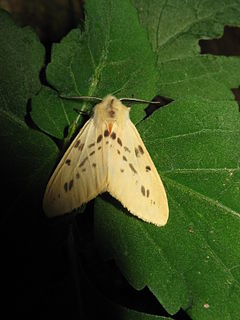Related Research Articles
In Greek mythology, Ceryx was a son of Hermes and either Pandrosus or Agraulus. He was, like his father, a messenger. But the kêryx career began as a humble cook for the tribe, a skill Hermes demonstrates in his cooked meat offerings on the Twelve Gods Altar set in place 522BC by Peisistratos III in Athens. The Homeric Hymn to Hermes 128 recalls the young god cutting out and laying up twelve steaks on a flat rock or platamoni," the 12 Gods altar.
Spencer Le Marchant Moore was an English botanist.

Ceryx is a genus of moths in the family Erebidae. It was described by Hans Daniel Johan Wallengren in 1863.

Lemyra is a genus of tiger moths in the family Erebidae. The genus contains many species from East and South Asia, Sundaland and Australia. It was described by Francis Walker in 1856.

The Euphyes is genus of North American butterfly of the family Hesperiidae (skippers), subfamily Hesperiinae.
Similodonta is an extinct genus of early bivalve in the extinct family Praenuculidae. The genus is one of eleven genera in the subfamily Praenuculinae. Similodonta is known from Middle Ordovician through Middle Silurian fossils found in Europe and North America. The genus currently contains eight accepted species, Similodonta ceryx, Similodonta collina, Similodonta djupvikensis, Similodonta magna, Similodonta recurva, Similodonta spjeldnaesi, Similodonta wahli and the type species Similodonta similis.
Diaethria ceryx, the Ceryx eighty-eight, is a species of butterfly of the genus Diaethria. Diaethria ceryx was recorded for the first time in the coastal mountains in Manabí, Ecuador.
Cherra Companyganj State Railways (CCSR) was a narrow gauge mountain railway that existed in British India.

The palmflies are a common Asian butterfly genus found from India to the Solomon Islands. The caterpillars mimic leaves which they feed on. The adults mimic certain species.
Ceryx albimacula is a moth of the subfamily Arctiinae. It was described by Francis Walker in 1854. It is found in Cameroon, the Republic of the Congo, the Democratic Republic of the Congo, Equatorial Guinea, Gabon, Ghana, Ivory Coast, Nigeria and Sierra Leone.
Ceryx ampla is a moth of the subfamily Arctiinae. It was described by Francis Walker in 1864. It is found on Aru in Indonesia and Papua New Guinea.
Ceryx barombina is a moth of the subfamily Arctiinae. It was described by Max Gaede in 1926. It is found in Cameroon.
Ceryx basilewskyi is a moth of the family Erebidae. It was described by Sergius G. Kiriakoff in 1955. It is found in Burundi.
Ceryx cybelistes is a moth of the subfamily Arctiinae. It was described by William Jacob Holland in 1893. It is found in Gabon, Ghana and Uganda.
Ceryx hyalina is a moth of the subfamily Arctiinae. It was described by Frederic Moore in 1879. It is found in Myanmar and the Indian states of Sikkim and Assam.
Ceryx morobeensis is a moth of the subfamily Arctiinae. It was described by Obraztsov in 1957. It is found in New Guinea.
Ceryx salutator is a moth of the subfamily Arctiinae. It was described by Sergius G. Kiriakoff in 1965. It is found in the Democratic Republic of the Congo.
Ceryx fulvescens is a moth in the subfamily Arctiinae. It was described by Francis Walker in 1854. It is found in the Republic of the Congo, the Democratic Republic of the Congo, Kenya, Lesotho, Mozambique, Rwanda, Somalia, South Africa, Zambia and Zimbabwe.

Nevlin Porter and Johnson Spencer were African-American men who were lynched in Starkville, Mississippi for the alleged burning of a barn.
References
- ↑ Savela, Markku (December 21, 2015). "Ceryx cherra (Moore, 1879)". Lepidoptera and Some Other Life Forms. Retrieved October 31, 2019.
| This Ceryx-related article is a stub. You can help Wikipedia by expanding it. |